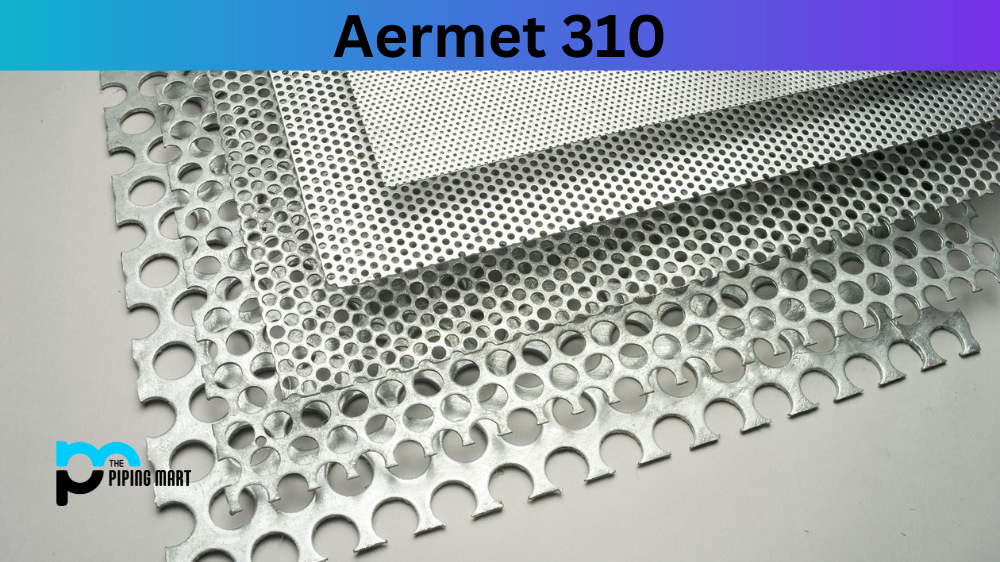Aermet 310 is a unique alloy that has become an essential material in different industries due to its exceptional properties and performance. It is a high-strength steel known for its excellent corrosion resistance, toughness, and mechanical properties. This post will dive into the specifics of the Aermet 310 composition, its mechanical and physical properties, uses, heat treatment, welding, and machining. Let’s explore this incredible material together!
Aermet 310 Composition
Aermet 310 is a nickel-cobalt-based alloy with chromium, tungsten, and molybdenum. Its composition makes it resistant to corrosion, wear, and fatigue, which is critical in various applications such as aircraft landing gear, drill collars, turbine engine components, and missile systems. The high amount of nickel in the alloy makes it resistant to sulfide stress cracking, while tungsten improves its high-temperature strength and toughness. Its cobalt content helps maintain its strength at elevated temperatures.
| Component Elements Properties | Metric | English | Comments |
|---|---|---|---|
| Carbon, C | 0.25 % | 0.25 % | |
| Chromium, Cr | 2.4 % | 2.4 % | |
| Cobalt, Co | 15 % | 15 % | |
| Iron, Fe | 69.95 % | 69.95 % | |
| Molybdenum, Mo | 1.4 % | 1.4 % | |
| Nickel, Ni | 11 % | 11 % |
Aermet 310 Mechanical Properties
Aermet 310 has excellent mechanical properties, making it unique compared to other alloys. It has a high yield strength of 310 ksi and a tensile strength of 340 ksi, which makes it ideal for high-stress applications. Its toughness is impressive, with a Charpy impact value of 60 ft-lbs at room temperature and 45 ft-lbs at -100°F. This alloy is also highly fatigue-resistant, making it perfect for cyclic loading applications.
| Mechanical Properties | Metric | English | Comments |
|---|---|---|---|
| Tensile Strength, Ultimate | 2170 MPa | 315000 psi | |
| Tensile Strength, Yield | 1900 MPa | 275000 psi | |
| Elongation at Break | 14.5 % | 14.5 % | |
| Reduction of Area | 63 % | 63 % | |
| Tensile Modulus | 192 GPa | 27900 ksi | |
| Fatigue Strength | 1030 MPa @# of Cycles 1.00e+7 |
150000 psi @# of Cycles 1.00e+7 |
R=-1, Kt=1 |
| Fracture Toughness | 71.42 MPa-m½ | 65.00 ksi-in½ | |
| Charpy Impact | 27.1 J | 20.0 ft-lb |
Aermet 310 Physical Properties
The physical properties of Aermet 310 are also worth noting. It has a density of 0.288 lb/in³, higher than other alloys. Its thermal conductivity is 49.2 BTU/hr-ft-°F, while its specific heat is 0.12 BTU/lb-°F. These properties make it a unique material that can withstand high-temperature applications.
| Physical Properties | Metric | English | Comments |
|---|---|---|---|
| Density | 7.97 g/cc | 0.288 lb/in³ |
Aermet 310 Uses
Aermet 310 has various applications in different industries, including aerospace, defence, oil drilling, and gas exploration. This alloy is used to manufacture landing gear components, engine parts, and missile systems. Due to its superior properties, it is also used in steel injection moulding and as armour plating in military vehicles.
Aermet 310 Heat Treatment
Heat treatment of Aermet 310 is a significant factor in its overall performance. It requires preheating before welding to prevent cracking and improve its toughness. After welding, it must be post-weld heat-treated to improve its ductility and toughness. In addition, the alloy can be forged, rolled, and machined using conventional methods.
Aermet 310 Machining
Machining of Aermet 310 requires a low cutting speed and high feed rates to minimize heat generation and avoid work hardening. The material has a high work hardening capacity due to its high strength, which can cause tool wear and reduced machining accuracy. However, using carbide tools and coolants can significantly improve the machining process.
Aermet 310 Welding
Welding Aermet 310 can present a unique challenge for even experienced welders. This high-strength, corrosion-resistant alloy is designed for high-pressure, high-temperature applications, so welding it is no easy feat. It requires expertise in managing high amounts of heat and using a suitable filler metal. However, when done correctly, Aermet 310’s unparalleled durability and resistance make it an ideal choice for industries that require extreme performance. Proper training and execution are paramount for welding this particular alloy, but the results are well worth it.
Conclusion:
Aermet 310 is a remarkable alloy that has revolutionized various industries due to its exceptional properties. Its strength, toughness, and corrosion resistance are ideal for high-stress applications in defence, aerospace, and oil and gas exploration. The alloy’s composition, physical and mechanical properties make it a unique material that can withstand high-temperature applications. Its heat treatment and machining require specific techniques to optimize its performance. The future of Aermet 310 looks bright as researchers continue to develop new applications for this incredible alloy.

Pipingmart is a B2B portal that specializes in metal, industrial and piping items. Additionally, we share the latest information and information about materials, products and various types of grades to assist businesses that are involved in this business.




